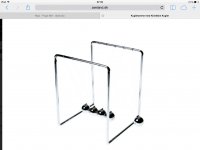Hi,
returning to the Abraxas.
The simulation schematic shows a stepping of the Ry resistors that define the current distribution between the CFPs Master- and Slave-transistors.
It is chosen ~71R for equal current values.
The resistor in the Master´s collector path adds a bit noise, so a small enough resistor value is wished for.
If one makes the resistor larger on the other hand, the current distribution becomes such, that less current is routed through the Master and more through the Slave, which is positive for THD.
My own sims showed that increasing Ry to 330R lead to THD-values of more than an order lower with an noise penalty of less than 1dB.
Simmed with 1mV @1kHz input voltage the difference is not that obvious, but at higher input voltages (10mV), which occur due to the raising RIAA-response towards the upper audio range.
The smaller the current setting resistor of a CFP, hence the lower the slave´s current, the less CFPish it looks, and the more it looks like a single transistor.
Was there any not yet mentioned reason to choose the Ry so low?
jauu
Calvin
ps. will we meet at HE in MUC in a month?
pps. You may have noticed the addition of a DC-Servo to the Calvin-Buffer in the Preamp-Buffers Thread
returning to the Abraxas.
The simulation schematic shows a stepping of the Ry resistors that define the current distribution between the CFPs Master- and Slave-transistors.
It is chosen ~71R for equal current values.
The resistor in the Master´s collector path adds a bit noise, so a small enough resistor value is wished for.
If one makes the resistor larger on the other hand, the current distribution becomes such, that less current is routed through the Master and more through the Slave, which is positive for THD.
My own sims showed that increasing Ry to 330R lead to THD-values of more than an order lower with an noise penalty of less than 1dB.
Simmed with 1mV @1kHz input voltage the difference is not that obvious, but at higher input voltages (10mV), which occur due to the raising RIAA-response towards the upper audio range.
The smaller the current setting resistor of a CFP, hence the lower the slave´s current, the less CFPish it looks, and the more it looks like a single transistor.
Was there any not yet mentioned reason to choose the Ry so low?
jauu
Calvin
ps. will we meet at HE in MUC in a month?
pps. You may have noticed the addition of a DC-Servo to the Calvin-Buffer in the Preamp-Buffers Thread
Last edited:
Yes, that was equal current distribution.
As far as i can tell the circuit simulated with very low distortion but we did not try to make Ry as high as you did plus i can not remember at what maximum voltage we simed.
Do you mind if you publish the version that you like best ?
I have a prototype working of the Abraxas and i could compare your version with what i have.
I have looked up the Simple Ideas thread from time to time. I will look it up again.
As far as i can tell the circuit simulated with very low distortion but we did not try to make Ry as high as you did plus i can not remember at what maximum voltage we simed.
Do you mind if you publish the version that you like best ?
I have a prototype working of the Abraxas and i could compare your version with what i have.
I have looked up the Simple Ideas thread from time to time. I will look it up again.
You can look at my Kmultiplier page for descriptions about how Ry affects CFP behavior. It speaks from a perspective of output impedance behavior. Since this output impedance is nonlinear and in series with the gain resistors, it directly contributes to distortion. The basic idea is, with low Ry the output impedance is like that of 2 diodes in series (120mV/decade). With high Ry the output impedance is like that of just one diode (60mV/decade). The latter case is more linear, although the CFP transconductance is actually smaller due to absolute bias. There are a number of ways to compromise with the CFP.
I expect the optimal points for noise and distortion will not be the same.
I expect the optimal points for noise and distortion will not be the same.
Interesting circuit in #9772, maybe you can use 8 parallel BF862 in the input jfet as Syn08 use on his HPS 5.1 Mc amplifier.
Syn08 claims less than 0.3nv/rtHz for his amplifier.
In BF862 datasheet it indicates that the equivalent noise input voltage is only 0.8nv/rtHz.
Low Noise Design Schematics
Syn08 claims less than 0.3nv/rtHz for his amplifier.
In BF862 datasheet it indicates that the equivalent noise input voltage is only 0.8nv/rtHz.
Low Noise Design Schematics
goes into the balanced input stage of the AD converter. The RIAA compensation ( or others like Decca, EMI etc. ) is then done in DSP with software. .
Quite the way to go...
Any chance to see that in public (my frickelfestforum account has been defeated)?
Rüdiger
busy doing things...
I do not spend time for diy at the moment and my work bench is collecting dust, but my passion for music is still alive (of course) and I'm using my gear.
And lurking around here from time to time...
That A/D-D/A-phono is something I'd really like to listen to.
Rüdiger
I do not spend time for diy at the moment and my work bench is collecting dust, but my passion for music is still alive (of course) and I'm using my gear.
And lurking around here from time to time...
That A/D-D/A-phono is something I'd really like to listen to.
Rüdiger
